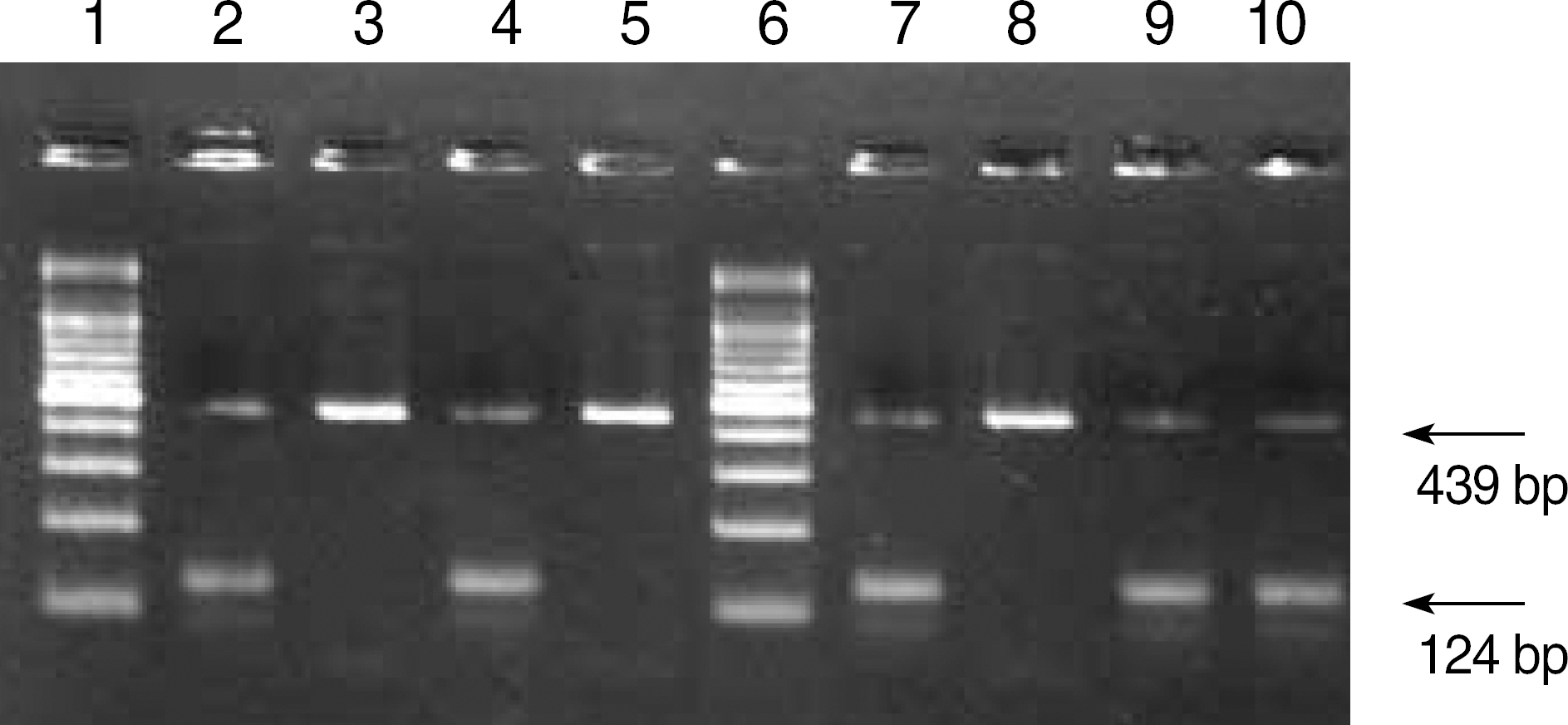Korean J Lab Med.
2006 Apr;26(2):114-118. 10.3343/kjlm.2006.26.2.114.
Gene Frequencies of Human Neutrophil Antigens 4a and 5a in the Korean Population
- Affiliations
-
- 1Department of Laboratory Medicine, Inje University Sanggyep Paik Hospital1, Seoul, Korea.
- 2Department of Laboratory Medicine, College of Medicine, Seoul National University, Seoul, Korea. kshanmd@snu.ac.kr
- KMID: 2238901
- DOI: http://doi.org/10.3343/kjlm.2006.26.2.114
Abstract
-
BACKGROUND: In Korean population, antigen frequencies of HNA-1a, HNA-1b, and HNA-2a are determined using a serological and genotyping method. However, no study has been done to assess the gene frequencies of HNA-4a and HNA-5a. It has been reported that the antibody against HNA-4a is associated with alloimmune neutropenia and autoimune neutropenia; however, there is no confirmed clinical report on anti-HNA-5a-related disorders. The aim of this study was to determine HNA-4a and HNA-5a gene frequencies among the Korean population.
METHODS
Genotyping of HNA-4a and HNA-5a genes of 110 healthy and unrelated Korean donors was performed using a polymerase chain reaction with sequence-specific primers and an allelespecific restriction enzyme analysis.
RESULTS
We found that the gene frequencies of HNA-4a and HNA-5a were 0.99 (107/110) and 0.96 (3/110), respectively, among the Korean population. But only the ones of the latter was significantly higher (P<0.01) than in the one of Caucasians.
CONCLUSIONS
The gene frequencies of HNA-4a and HNA-5a were determined. We also identified an individual who was the HNA-5a-negative homozygote for the granulocyte panel that could be used for anti-HNA-5a antibody identification.
Keyword
MeSH Terms
Figure
Reference
-
References
1. Lalezari P, Radel E. Neutrophil-specific antigens: immunology and clinical significance. Semin Hematol. 1974; 11:281–90.2. Bux J. Molecular nature of granulocyte antigens. Transfus Clin Biol. 2001; 8:242–7.3. Stroncek D. Granulocyte antigens and antibody detection. Vox Sang. 2004; 87:91–4.4. Fung YL, Pitcher LA, Willett JE, Reed C, Mison L, Bux J, et al. Alloimmune neonatal neutropenia linked to anti-HNA-4a. Transfus Med. 2003; 13:49–52.
Article5. Simsek S, van der Schoot CE, Daams M, Huiskes E, Clay M, McCullough J, et al. Molecular characterization of antigenic polymorphisms (Ond(a) and Mart(a)) of the beta 2 family recognized by human leukocyte alloantisera. Blood. 1996; 88:1350–8.
Article6. Clague HD, Fung YL, Minchinton RM. Human neutrophil antigen-4a gene frequencies in an Australian population, determined by a new polymerase chain reaction method using sequence-specific primers. Transfus Med. 2003; 13:149–52.
Article7. Hartman KR, Wright DG. Identification of autoantibodies specific for the neutrophil adhesion glycoproteins CD11b/CD18 in patients with autoimmune neutropenia. Blood. 1991; 78:1096–104.
Article8. Han KS, Um TH. Frequency of neutrophil-specific antigens among Koreans using the granulocyte indirect immunofluorescence test (GIFT). Immunohematology. 1997; 13:15–6.
Article9. Ohto H, Matsuo Y. Neutrophil-specific antigens and gene frequencies in Japanese. Transfusion. 1989; 29:654.
Article10. Lin M, Chen CC, Wang CL, Lee HL. Frequencies of neutrophil-specific antigens among Chinese in Taiwan. Vox Sang. 1994; 66:247.
Article11. Seo DH, Park SS, Han KS. Genotype analysis of granulocyte-specific antigens in Koreans. Korean J Clin Pathol. 1997; 17:1144–9.12. Fujiwara K, Watanabe Y, Mitsunaga S, Oka T, Yamane A, Akaza T, et al. Determination of granulocyte-specific antigens on neutrophil FcA receptor IIIb by PCR-preferential homoduplex formation assay, and gene frequencies in the Japanese population. Vox Sang. 1999; 77:218–22.13. Chu CC, Lee HL, Chu TW, Lin M. The use of genotyping to predict the phenotypes of human platelet antigens 1 through 5 and of neutrophil antigens in Taiwan. Transfusion. 2001; 41:1553–8.
Article14. Bux J. Nomenclature of granulocyte alloantigens. ISBT Working Party on Platelet and Granulocyte Serology, Granulocyte Antigen Working Party. International Society of Blood Transfusion. Transfusion. 1999; 39:662–3.15. Lucas GF, Metcalfe P. Platelet and granulocyte glycoprotein polymorphisms. Transfus Med. 2000; 10:157–74.
Article16. Lalezari P. Nomenclature for neutrophil-specific antigens. Transfusion. 2002; 42:1396–7.
Article
- Full Text Links
- Actions
-
Cited
- CITED
-
- Close
- Share
- Similar articles
-
- Gene Frequency of Human Neutrophil Alloantigen-3 in the Korean Population
- HLA-DR Antigens and HLA-B: DR Haplotypes in Koreans
- Human Platelet Antigen Genotyping Using a Multiplex Single-Base Primer Extension Reaction in Koreans
- Genotype Frequencies of Platelet Glycoprotein IIIa-Specific Antigens and Granulocyte Antigens In Korean Pregnant Women*
- The Genotype Frequencies of Platelet-Specific Antigens in Koreans



